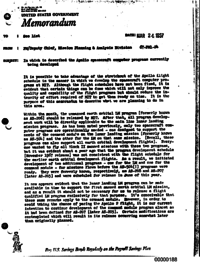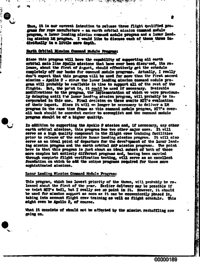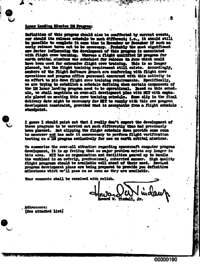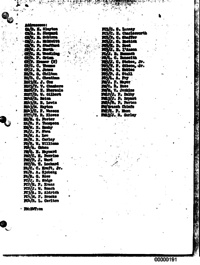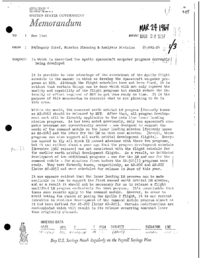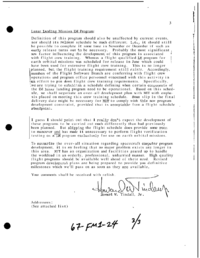See listMAR 24 196767-FM1-24FM/Deputy Chief, Mission Planning & Analysis DivisionIn which is described the Apollo spacecraft computer programs currently being developed
It is possible to take advantage of the stretchout of the Apollo flight schedule in the manner in which we develop the spacecraft computer pro- grams at MIT. Although the flight schedules have not been fixed, it is evident that certain things can be done which will not only improve the quality and capability of the flight programs but should reduce the in- tensity of effort required of MIT to get them ready on time. It is the purpose of this memorandum to describe what we are planning to do in this area.
Within the month, the unmanned earth orbital LM program [formerly known as AS-206] should be released by MIT. After that, all program develop- ment work will be directly applicable to the main line lunar landing mission programs. As has been noted previously, only two spacecraft com- puter programs are operationally needed – one designed to support the needs of the commend module on the lunar landing mission [formerly known as AS-504] and the other for the LM on that same mission. [Recall, these programs can also support all earth orbital development flights]. Every- one wanted to fly all Block II manned missions with these two programs, but it was evident about a year ago that the program development schedule [November 1967 release] was not consistent with the flight schedule for the earlier earth orbital development flights. As a result, we initiated development of two additional programs – one for the LM and one for the command module – for missions flown before the AS-504(!) programs were ready. They were formerly known, respectively, as AS-208 and AS-207 [later AS-205] and were scheduled for release in June of this year.
It now appears evident that the lunar landing LM program can he made available in time to support the first manned earth orbital LM mission, and as a result it should not be necessary for us to release a flight qualified LM program exclusively for that purpose. It's conceivable that these same remarks apply to the command module. However, in order to avoid taking the chance of pacing the Apollo 2 flight, it is our current intention to continue development of the command module program almost as it had been defined for AS-207 [later AS-205]. Certain modifications are contemplated which will result in its release occurring somewhat later than originally planned.
Thus, it is our current intention to release three flight qualified pro- grams for rope manufacture – an earth orbital mission command module program, a lunar landing mission command module program and a lunar land- ing mission LM program. I would like to discuss each of these three in- dividually in a little more depth.
Earth Orbital Mission Command Module Program:
Since this program will have the capability of supporting all earth orbital main line Apollo missions that have ever been discussed, its re- lease, about the first of August, should effectively get the schedule completely off our backs for command module programs. Actually, I really don't expect that this program will be used for more than the first manned mission – Apollo 2 – since the lunar landing mission command module pro- gram will probably be available in time to support all of the rest of the flights. But, the point is, it could be used if necessary. Desirable modifications to the program, the implementation of which we were previous- ly delaying until the lunar landing mission program, will probably be in- corporated in this one. Final decision on these awaits MIT's evaluation of their impact. Since it will no longer be necessary to deliver a LM program in the tame time frame as this command module program, MIT's over- all task should be somewhat easier to accomplish and the command module program should be of a higher quality.
In addition to supporting the Apollo 2 mission and, if necessary, any other earth orbital missions, this program has two other major uses. It will serve as a high quality component in the flight crew training facilities prior to release of the entire lunar landing mission program. It will also serve as an ideal point of departure for the development of the lunar land- ing mission program and the earth orbital AAP mission programs. The point here is that this program is just about an ideal subset of both of those more complex but entirely different programs and, having been carried through complete flight verification testing, will serve as an excellent foundation on which to add the unique programs required for those more sophisticated missions.
Lunar Landing Mission Command Module Program:
This program, which has lowest priority of the three, will probably be re- leased about the first of the year. Earlier delivery may be possible if we twist MIT's tail, but I really see no point in it. However, it should be used for mission support as soon as it can be conveniently phased in, taking into account flight crew training as well as flight schedule. This might even be Apollo 2, of course.
What it consists of should not be affected by the mission reshuffling now going on.
Lunar Landing Mission LM Program:
Definition of this program should also be unaffected by current events, nor should its release schedule be much different; i.e., it should still be possible to complete it some time in November or December if such an early release turns out to be necessary. Probably the most significant new factor influencing the development of this program is associated with flight crew training. Whereas a flight qualified LM program for earth orbital missions was scheduled for release in June which could have been used for extensive flight crew training. This is no longer planned, but the flight training requirement still exists. Accordingly, members of the Flight Software Branch are conferring with flight crew operations and program office personnel concerned with this activity in an effort to pin down flight crew training requirements. Specifically, we are trying to establish a schedule defining when certain components of the LM lunar landing program need to be operational. Based on this sched- ule, we shall negotiate an over-all development plan with MIT with empha- sis placed on meeting this crew training schedule. Some slip in the final delivery date might be necessary for MIT to comply with this new program development constraint, provided that is acceptable from a flight schedule standpoint.
I guess I should point out that I really don't expect the development of these programs to be carried out much differently than had previously been planned. But slipping the flight schedule does provide some room to maneuver and has made it unnecessary to perform flight verification testing on a LM program exclusively for use on earth orbital missions.
To summarize the over-all situation regarding spacecraft computer program development, it is my feeling that no major problem exists any longer in this area. MIT has an organization and facilities geared up to handle the workload in an orderly, professional, unhurried manner. High quality flight programs should be available well ahead of their need. Revised program development plans are being prepared to provide you definitive milestones which we'll pass on as soon as they are available.
Your comments shall be received with relish.
- May 08, 1969 – The LM4 RR/LGC interface may be broken, but that’s okay – sorta (4.1σ)
- Apr 28, 1967 – Notes from the MIT program development plan meeting of April 12 (3.7σ)
- Nov 28, 1966 – More interesting things about our work with MIT (3.4σ)
- Apr 25, 1967 – Contract NAS 9-4065, Letter of Direction Concerning Program Development (3.4σ)
- Jan 18, 1967 – AS-504 Spacecraft Computer Programs will be able to support earth orbital and lunar missions (3.3σ)
- Mar 02, 1967 – Progress Report – RTCC program development reduction – Review of requirements for the AS-502 mission (3.0σ)
- Mar 13, 1968 – TRW performance evaluation for Task A-46 (3.1σ)

